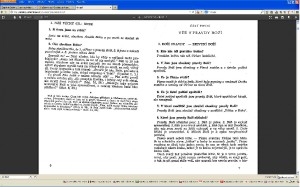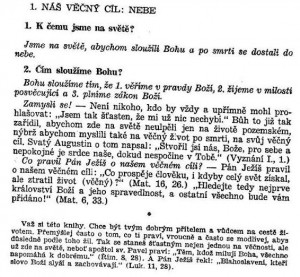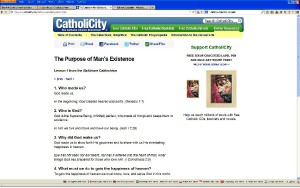Tomáškův katechismus & Baltimore Catchism
František kardinál Tomášek (1899–1992) – arcibiskup pražský a primas český
Katechismus katolického náboženství (1. vyd. 1955) Katechismus katolického náboženství je katechismus, jehož autorem je kardinál František Tomášek, v době prvního vydání katechismu (1955) biskup. Je proto také označován jako tzv. Tomáškův katechismus.
http://katolicky-katechismus.cz/wp-content/uploads/kkn.pdf
J.Em. Profesor František kardinál Tomášek (30. června 1899 Studénka – 4. srpna 1992 Praha) byl katolický kněz, pedagog a teolog, apoštolský administrátor pražské arcidiecéze (1965–1977) a 34. arcibiskup pražský a primas český (1977–1991).
František Tomášek působil dlouhou dobu v katolickém školství, zejména jako katecheta a školní inspektor. Oblast výuky a výchovy jej nepřestala zajímat po celý jeho život, napsal a vydal řadu učebnic a populárně-naučných knih na toto téma. V roce 1949 byl tajně vysvěcen na biskupa a stal se součástí podzemní církve. V roce 1951 byl zatčen a poté bez soudu poslán na nucené práce. Po propuštění působil jako administrátor Moravské Huzové (1954–1965).
Byl výrazným účastníkem Druhého vatikánského koncilu, a ještě před jeho ukončením se stal administrátorem pražské arcidiecéze. Na tomto postu čím dál rázněji vystupoval proti pronásledování katolické církve a kritizoval komunistický útlak. Pavel VI. jej jmenoval kardinálem a arcibiskupem pražským.
Jako arcibiskup a kardinál se stále více vzpíral komunistickým zásahům do života církve, spoluinicioval hnutí Dílo koncilové obnovy i vznik programu Desetiletí duchovní obnovy a zasadil se o svatořečení Anežky České. V listopadu 1989, kdy se svatořečení uskutečnilo, podpořil sametovou revoluci a přispěl ke svržení komunistického režimu. Podílel se na přípravě první návštěvy papeže Jana Pavla II. v České republice (1990) a ještě před jejím uskutečněním oznámil svoji rezignaci na arcibiskupský stolec z důvodu vysokého věku a špatného zdraví. Zemřel v létě 1992 ve věku 93 let.


http://katolicky-katechismus.cz/
pochopit svým rozumem, protože tyto pravdy máme od Boha.
Božskou, nadpřirozenou víru si nemůže nikdo dát sám. Je to veliký dar, neboli milost od Boha. Tento dar božské, nadpřirozené víry jsme dostali s milostí posvěcující. Máme za něj děkovat a také se modlit za to, abychom si jej vždy zachovali, upevňovali a rozmnožovali.
Proto s modlitbou a s touto božskou, nadpřirozenou vírou ber do ruky tuto knihu.
Katechismus katolického náboženství není jen k poznávání Božích pravd, je hlavně k tomu, abys jim nadpřirozenou vírou radostně věřil, podle nich se řídil ve svém denním životě a podle nich opravdu žil. K tomu ovšem zase potřebuješ Boží pomoc. Proto začínej i konči četbu katechismu vždy modlitbou.
* * *
Katechismus Katolického Náboženství
Napsal Th Dr. František Tomášek
Ordinarius Pragensis.
NIHIL OBSTAT
Can. Dr. Franciscus Kotalík
censor.
IMPRIMATUR
Pragae, die 26. Novembris 1955
Prael. Antonius Stehlík,
vicarius capitularis.
Nr.: Ord. 165/55
KOREKTURA:
Nakladatelství MICHAEL S.A.
Frýdek-Místek, 2007
Baltimore Catechism
A Catechism of Christian Doctrine, Prepared and Enjoined by Order of the Third Council of Baltimore (or, simply, the Baltimore Catechism[1]) was the de facto standard Catholic school text in the United States from 1885 to the late 1960s. It was the first such catechism written for Catholics in North America, replacing a translation of Bellarmine's Small Catechism. In response to criticisms, various editions include annotations or other modifications. The Baltimore Catechism remained in use in nearly all Catholic schools until many moved away from catechism-based education, though it is still used up to this day in some.
http://www.catholicity.com/baltimore-catechism/

Lesson 1 from the Baltimore Cathechism
1. Who made us?
God made us.
In the beginning, God created heaven and earth. (Genesis 1:1)
2. Who is God?
God is the Supreme Being, infinitely perfect, who made all things and keeps them in existence.
In him we live and move and have our being. (Acts 17:28)
3. Why did God make us?
God made us to show forth His goodness and to share with us His everlasting happiness in heaven.
Eye has not seen nor ear heard, nor has it entered into the heart of man, what things God has prepared for those who love him. (I Corinthians 2:9)
4. What must we do to gain the happiness of heaven?
To gain the happiness of heaven we must know, love, and serve God in this world.
Lay not up to yourselves treasures on earth; where the rust and moth consume and where thieves break through and steal. But lay up to yourselves treasures in heaven; where neither the rust nor moth doth consume, and where thieves do not break through nor steal. (Matthew 6:19-20)
5. From whom do we learn to know, love, and serve God?
We learn to know, love, and serve God from Jesus Christ, the Son of God, who teaches us through the Catholic Church.
I have come a light into the world that whoever believes in Me may not remain in darkness. (John 12:46)
6. Where do we find the chief truths taught by Jesus Christ through the Catholic Church?
We find the chief truths taught by Jesus Christ through the Catholic Church in the Apostles' Creed.
He that heareth you heareth me; and he that despiseth you despiseth me; and he that despiseth me despiseth him that sent me. (Luke 10:16)
7. Say the Apostles' Creed.
I believe in God, the Father Almighty, Creator of heaven and earth; and in Jesus Christ, His only Son, Our Lord; who was conceived by the Holy Ghost, born of the Virgin Mary, suffered under Pontius Pilate, was crucified, died and was buried. He descended into hell; the third day He arose again from the dead; He ascended into heaven, sitteth at the right hand of God, the Father Almighty; from thence He shall come to judge the living and the dead. I believe in the Holy Ghost, the Holy Catholic Church, the communion of Saints, the forgiveness of sins, the resurrection of the body, and life everlasting. Amen.
Volumes
Volume 1 The 33 lessons contained in Baltimore Catechism No. 1 present the basics of the Catholic Faith in a manner suitable for First Communicants through fifth graders.
Volume 2 The 37 lessons contained in Baltimore Catechism No. 2 present the fundamentals of the Catholic Faith in a manner suitable for sixth through ninth graders and those preparing for Confirmation.
Volume 3 The lessons contained in Baltimore Catechism No. 3 are intended for students who have received their Confirmation and/or high schoolers. It includes additional questions, definitions, examples, and applications that build upon the content of the original Baltimore Catechism (No. 2).
Volume 4 An Explanation of the Baltimore Catechism can be used as a reference work, or as a teacher's manual for the original Baltimore Catechisms. It is often used as an advanced textbook. Its explanations of many little known questions pertaining to the Catholic Faith are designed to reward the questioning reader.
External links
- Baltimore Catechism No. 1 at Project Gutenberg. An abridged edition for younger students.
- Baltimore Catechism No. 2 at Project Gutenberg. The main edition.
- Baltimore Catechism No. 3 at Project Gutenberg. An expanded edition for older students.
- Baltimore Catechism No. 4 at Project Gutenberg. An annotated edition for teachers.
See also
- Catechism of the Catholic Church - a more recent official catechism of the Church
![]() This article incorporates text from a publication now in the public domain: Herbermann, Charles, ed. (1913). Catholic Encyclopedia. Robert Appleton Company.
This article incorporates text from a publication now in the public domain: Herbermann, Charles, ed. (1913). Catholic Encyclopedia. Robert Appleton Company.
References
SEE ALSO THIS LINK http://en.wikipedia.org/wiki/Catechism_of_the_Catholic_Church
